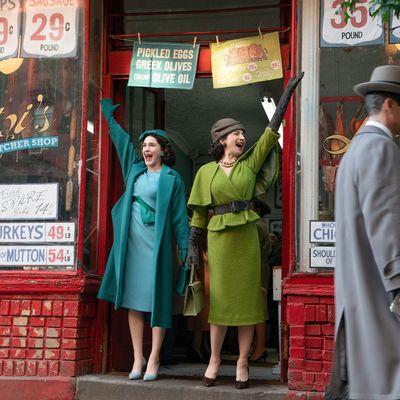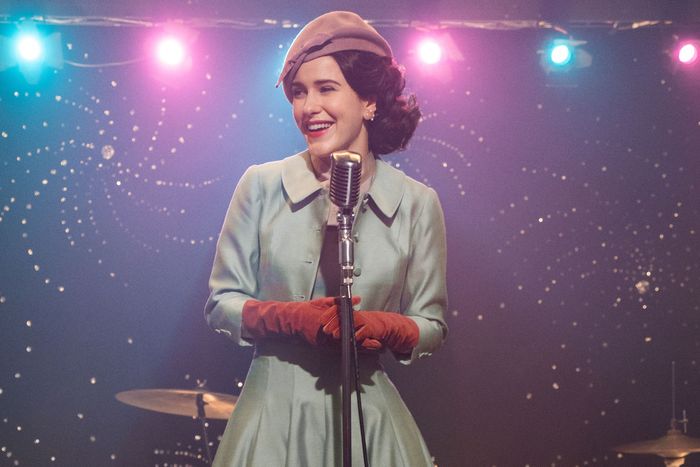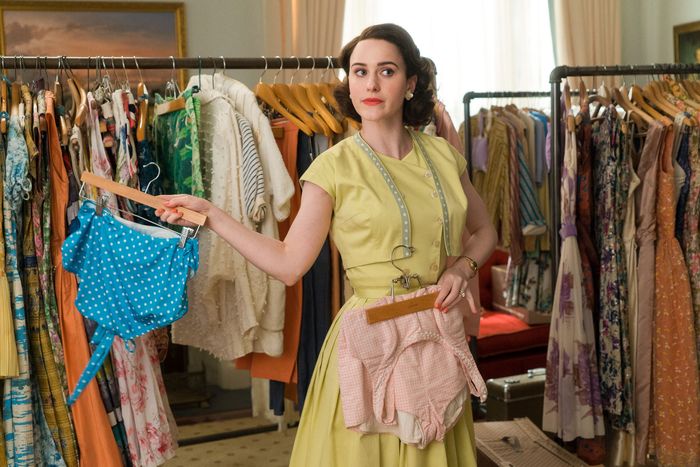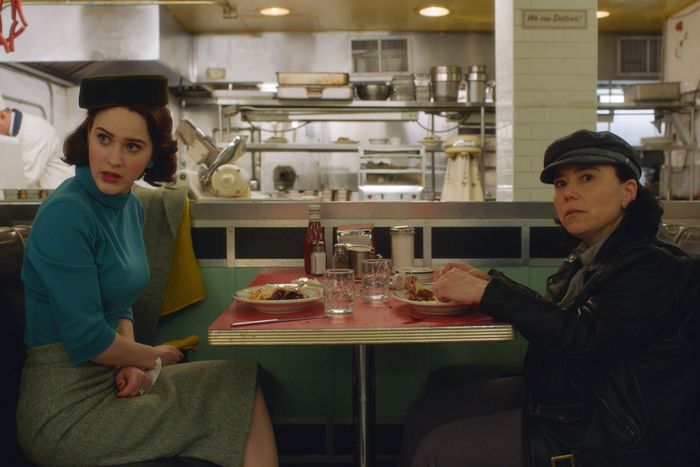
The second season of The Marvelous Mrs. Maisel is, like all of Amy Sherman-Palladino’s work, distinctive, often divisive, and immediately recognizable as part of the oeuvre of the Emmy-winning creator of Gilmore Girls and Bunheads. Here are some of the most manifestly Sherman-Palladino moments in the season, from the eye-roll-inducing fat jokes, to the delightfully bizarre Steiner Boys, to the apparently indispensable dance competition.
Opening with Barbra singing Hello, Dolly!
The Marvelous Mrs. Maisel isn’t a musical, but Amy Sherman-Palladino owes a debt to the rhythms of musical comedy (especially classic musical comedy) with the pride of someone belting Jerry Herman musicals at Marie’s Crisis at 2 a.m. Case in bombastic point: The second season opens with a dizzying long take set to “Just Leave Everything to Me,” the song Herman wrote for the movie adaptation of Hello, Dolly! The song evokes the spirit of Midge’s personality as the ultimate meddler, and given that it’s pretty hard to get Barbra Streisand to license her music, it establishes just how much liberty Mrs. Maisel is going to take with its budget in the second season. The Hello, Dolly! movie didn’t come out until 1969, well after the time period in which Mrs. Maisel is set, but it’s even more of a Sherman-Palladino move to sidle right past chronology for the sake of a mood.
Taking the show to Paris simply because
Why not abandon all the forward momentum of your story right as you’re getting it going, so that you can lose yourself in a dubiously relevant but unquestionably delightful tangent? Even better, why not do it … in Paris! Lorelai and Christopher ran off to Paris to save their relationship late in Gilmore Girls; things go much better for Rose and Abe.
Midge doing stand-up in translation
Even in Paris, Midge can’t resist a spotlight. She stumbles onstage during a drag act and offers some light commentary on her time in France, which a helpful American expat translates for the European audience. In classic ASP style, the dialogue accelerates until Midge and the translator are speaking over each other in French and English at the same time, though the audience somehow still understands enough to laugh along with the jokes. The scene regains a tad of the show’s forward momentum via a flashback that explains how Midge and Joel broke up after the end of season one, which depresses everyone in the club. Then, because ASP would never let an emotional beat pass without hanging a hat and/or beret on it, Mrs. Maisel catapults back into meta-commentary by having a French audience member insist that he much prefers Jerry Lewis.
A quirky canine companion
When Rose absconds to Paris early in the second season, she acquires, in addition to an affinity for harsh French cigarettes and a shabby-chic (emphasis on the “shabby”) apartment, a cute little dachshund named Simone, who gives the season-two premiere episode its title. Like Paul Anka and Annie the “service dog” before her, Simone serves as both an object of comfort to a woman struggling through a transitional point in her life and a scruffy little flourish providing the sort of colorful quirk that comprises the backdrop of any ASP show.
Midge’s crash-and-burn wedding speech
No wedding in Amy Sherman-Palladino’s world should go off without a hitch, so it’s utterly unsurprising that a low-key wedding for one of Midge’s co-workers becomes a chance for Midge to self-destruct. Nothing says “I’m a woman who’s too oddball to conform to the typical expectations of heterosexual milestones” like bombing a wedding toast.
A preoccupation with thinness
An early episode of Mrs. Maisel’s second season finds Susie Myerson puttering around in the Weissmans’ apartment, where she finds the notebook Midge uses to carefully record her exact bodily measurement every day. Curious, Susie then measures her own thighs, which are obviously much bigger than Midge’s. This whole thing could be chalked up as a strange, unfortunate choice, except a preoccupation with thinness and weight and bodies is everywhere in Sherman-Palladino’s work. The pool scene in Gilmore Girls: A Year in the Life is the worst of them, but it’s not alone. Do better, ASP!
Midge and Rose packing for the Catskills
How can you possibly pick which clothes to take with you on an epic vacation? There’s no way! You have to bring them all. Every single item. Even though they don’t fit in your luggage. What if you need that dress? Always bring everything. Plus all luggage is inherently funny.
The Steiner Boys
The Steiner Boys, those buzzing, ever-present, ever-anxious aides who fly around bringing you tomato juice at the drop of a hat while you stay at a resort in the Catskills, are a fever dream of youthful masculinity dedicated to a life of service. Like almost any ASP minor character, they are inhuman, hilarious, and just so weird. They do not walk; they only jog or sprint. They are never not offering you something. They are both amazing at their jobs and completely terrible at them.
Zachary Levi as a crush-worthy rich asshole
It’s hard to know if ASP ever watched Chuck, but given that she’s a fan of musical theater, she definitely saw Zachary Levi in She Loves Me on Broadway (directed by Scott Ellis, who’s also directed a few Maisel episodes). One imagines her thinking, like Michelangelo eyeing a piece of marble, I can carve something good out of that. Levi arrives mid-season as a stern Manhattan doctor, a.k.a. the rich asshole you’re supposed to hate but also have a crush on. He’s rude and he’s distant, but he has a good sense of humor and he’s willing to provide an excuse for you to lie to your mom — a.k.a. the ASP dream man.
A dance competition
It’s not just that there’s a dancing scene in The Marvelous Mrs Maisel, after Amy Sherman-Palladino already made a show about dancing. It’s not that it’s a dance-competition scene, even though the very best episode in her most famous, career-making show is about a 24-hour dance competition. It’s not even that Steiner’s dance competition also has weirdly arcane rules. But this scene in Mrs Maisel even uses the same music as the competition in Gilmore Girls’ dance episode, “They Shoot Gilmores, Don’t They?” An alien from Neptune could land on this planet tomorrow, be shown this scene and this scene only, and would immediately recognize it as part of an ASP joint.
Tony Shalhoub in a onesie
Mrs. Maisel doesn’t have a village of goofy supporting characters to pull from in the same way that Gilmore Girls or Bunheads could, but the show never lacks for the sort of odd running gags those shows tended to assign to townspeople. Once the Weissmans arrive in the Catskills, Tony Shalhoub’s dour and serious patriarch switches into vacation mode, drinking lots of tomato-juice-based beverages and doing his morning exercises on a dock in a romper. Shalhoub invests all this, especially the pronunciation of the word romper, with the gravitas of someone performing Arthur Miller, which only makes it funnier.
The Stage Deli’s good booth
The characters on Maisel are people of habit and certainty. Though you might not be able to know, they like to do what they like to do and to sit where they like to sit, and in the case of Susie and Midge, they will bully you out of the diner booth they prefer if they want to sit in it. Rory and Lorelai had their spot at Luke’s and the same goes for Midge and Susie here, down to their seemingly endless appetite for and opinions about whatever’s on the menu.
The fact that Joel is still hanging around
Think of Christopher and Lorelai, or Rory and Dean: People may break up in Amy Sherman-Palladino shows, but they have a tendency to bounce back together, again and again and again. Maisel starts with a marriage breaking up, but Joel remains very much in the picture, even if his attempts to manage his family business having nothing to do with the rest of the plot. Joel will always be a part of Midge’s life since they have kids (even if she and the show tend to forget about them), but the fact that he has such a large presence is another sign of ASP’s fascination with men who are bad for you but always seem to stick around.
A remarkably white universe
Gilmore Girls took place in a version of Connecticut with hardly any people of color (as has been documented thoroughly online), and Bunheads depicted a small town in California that was similarly pale. Even though Maisel includes several background actors played by people of color (in the same way that Netflix’s Gilmore Girls: A Year in the Life suddenly made Stars Hollow a lot more diverse), its principal cast is still starkly monotone. Midge Maisel does live in the 1950s, and you could argue that the whiteness of her world is accurate, but as the show dives into the era’s alt-comedy world and its larger gender politics, it’s remarkable how uninterested it remains in engaging with race.




